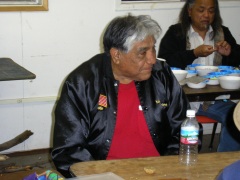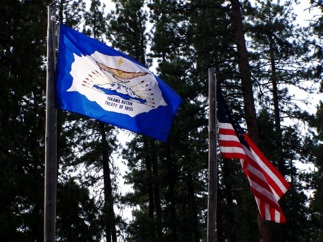In 1990, Joe Jay Pinkham, Secretary for the Yakama Nation, suggested the formation of an all-Indian Healing Camp for Indian Veterans. Subsequent development of an all-cohort Indian Group at American Lake VAMC didn't work because of infighting among the various participating tribes.
In May of 1991 in Toppenish, Washington, an Advisory Council was formed to address American Indian Health and healing within the VA. The Yakama Nation authorized the use of Camp Chaparral, on its sacred land, in 1991; funding became available in November of 1991 and the first Camp was held in 1992.
The Camp, which assumed the name of the sacred ground on which it was held, Camp Chaparral, was formed to teach or sensitize VA and other practitioners who work with Indian Veterans on the American Indian Traditional Methodology of Healing. The rest is history.
The core group for Camp Chaparral was: Dr. Don Johnson, Seattle Vet Center Team Leader (deceased), Steven Tice, Mr. Jim Bouley and Dave Mann aka "Coyote." Funding was a joint effort by Mr. Richard Murphy (deceased) and Mr. Barry Bell, former Portland VA Medical Center Director (deceased).
Camp Chaparral has experienced some changes over the years as attendance and interest has grown. Medical Administration Service Clerks, Physicians, Social Workers, Registered Nurses, and Administrators were among the first group to attend.
For the first four years, there was a progressive “journey” through the VA system, “from the eyes” of an American Indian veteran. An additional objective was to develop a significant percentage of VA staff with intimate personal awareness and sensitivity for American Indian culture. They were also provided a sense of American Indian culture and invited to apply a holistic approach to the care of Indian veterans.
Today, the camp concentrates on providing a unique and positive experience to the VA staff. It includes hands-on interaction with Native American warriors, spiritual leaders, traditional healers, and tribal Elders and families from the Yakama, Umatilla, Nez Perce, Sioux, Makah, Lummi, Warm Springs, Karuk, and Colville tribes.
Each family has an identified Indian Interpreter who facilitates and leads group members through a specially designed curriculum incorporating Native, as well as other veterans’ (staff members and others at large) issues and concerns surrounding quality service to persons with diverse needs and backgrounds. Additionally, Camp Chaparral offers an opportunity to see the interesting and provocative interface between Native American traditional healing and Western European (traditional) medicine.
Camp Chaparral explores how to listen to others, to respect the importance of family in the healing process and to hear the needs of other cultures. The ideas presented at the camp can be woven into many other realms of human communication, self-awareness and relations. Camp Chaparral has left a lasting impression on over 900 VA participants not simply as a place of beauty, but as a way of life in the work that the VA does.
Also in existence within the VA system are two other Native American programs sponsored by The Southern Arizona VA Health Care System in Tucson and VISN 23’s, the Black Hills Gathering of Healers. These programs vary in format and focus but both have an awareness component and are based on content and input from their local Native American tribes.






